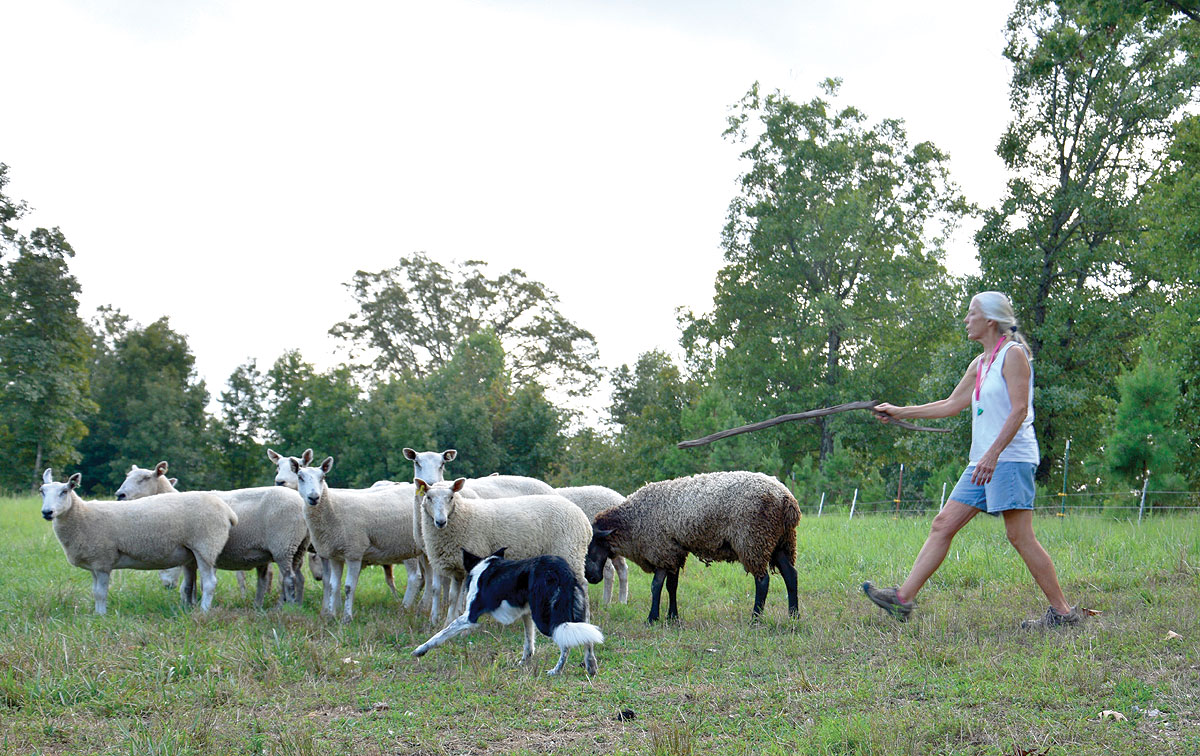
After driving by a neighbor’s flock for a time, Roberta Hamilton has fulfilled a dream
Nestled in a hollow near Powell, Mo., Roberta and Bill Hamilton tend to a flock of Cheviot ewes with the help of a pair of Border Collies.
Roberta is involved with nearly every aspect of the sheep business, from breeding, herding and selling, to spinning their wool and using it to make handcrafted goods. About the only thing she doesn’t do is shear the sheep herself.
Roberta got her start with Cheviot sheep in 2013 with 20 ewes after years of watching her neighbor’s flock from afar.
“I would drive by always watching their sheep, see the lambs in the spring and have ‘pastoral dreams’ year after year,” Roberta said. When the neighbors announced an upcoming auction and move, Roberta decided to take the plunge.
“I blurted out, ‘what about your sheep?’ We talked and I bought his flock the next week,” Roberta said.
A year into flock ownership, Roberta and Bill’s herding frustrations led to the search for a sheep dog.
“After chasing sheep around for a year and not understanding how or what either of us were doing, I found the Missouri Show Me Stock dog website and found there are better ways to herd sheep than sending out my husband to fetch,” Roberta said. She started out with a Border Collie named Zac and recently added another, Mirk.
“He knows a lot more about herding sheep than I do,” Roberta said.
Roberta has attended several clinics in Butler, Mo., to learn from Jack and Kathy Knox of Ettrick Kennels, and plans to take Mirk to one in November.
One dog can help manage a flock of 30-50 sheep helping move the flock and with everyday chores.
“I can even leave the gate open to bring in water and the dog will ‘hold’ the flock in the pasture,” she said.
While she’s kept the Cheviot lineage in her herd, she’s reduced her current flock to 16, with 15 Cheviot ewes and a Bluefaced Leicester ram named Ken.
“That number is the right fit for my pastures. It couldn’t handle 20, so I reduced the flock size,” she said.
Lambing season is one of Roberta’s favorite parts of spring.
“It took me the season to realize that these girls were great moms,” Roberta said. “They birthed easily without any help and were naturally easy to manage.”
The easy management extends to the breeding season.
“Sheep are seasonal breeders. They usually breed as the weather turns cooler, so a ram can be with the ewes most of the year,” Roberta said. She plans to start her fall breeding in early October.
“I expect the first lamb will be arriving approximately March 4, 2018. Lambing season is a great time,” Roberta said. “I like to get past the coldest weather in February and yet have the lushest spring grass coming in for the lambs and ewes to start on in March.”
After weaning, Roberta sells the lambs, with priority given to regular customers, most who buy them for meat. The rest are sold at auctions in the area.
The sheep are sheared each spring, and that’s when her focus turns to the fiber portion of her operation. It takes Roberta’s sheep shearer just one hour to shear the whole flock.
What looks like a large pile of wool in the beginning can dwindle by 50 percent once the wool is skirted, cleaned and roved. Most of the time, Roberta skirts the wool herself and then sends it to a fiber mill to be cleaned. Once it’s cleaned, the wool is combed into roving and spun.
“Through this process I have learned that I really don’t like the cleaning part,” Roberta said. “I do love to spin, but only when the evenings are long and darkness allows for inside time. And I do love to weave.
“My next project is a Ruana, which will be made from my Border Leicester/Cheviot wool, Angora rabbit/Corriedale wool and llama fibers,” Roberta said. “I like to keep all my wool but after four years, I understand why alpaca, llama and sheep people have barns full. This year I am taking my wool to the Fiber Daze in Mount Vernon, Mo., in September. I have raw, skirted fleece, roving and drop spindles for sale.”
It’s evident Roberta enjoys the entire process, from birth to making handmade goods.
“It’s neat to be there for the births, to watch them grow up and pick out which lambs to keep or sell,” Roberta said. “Some that were born from my first flock are part of my ewe flock now. It’s all fun. I think you enjoy it more when it’s an animal you raised.”







I loved this article!
Very interesting. And so exciting to see it was about my friends in Missouri!